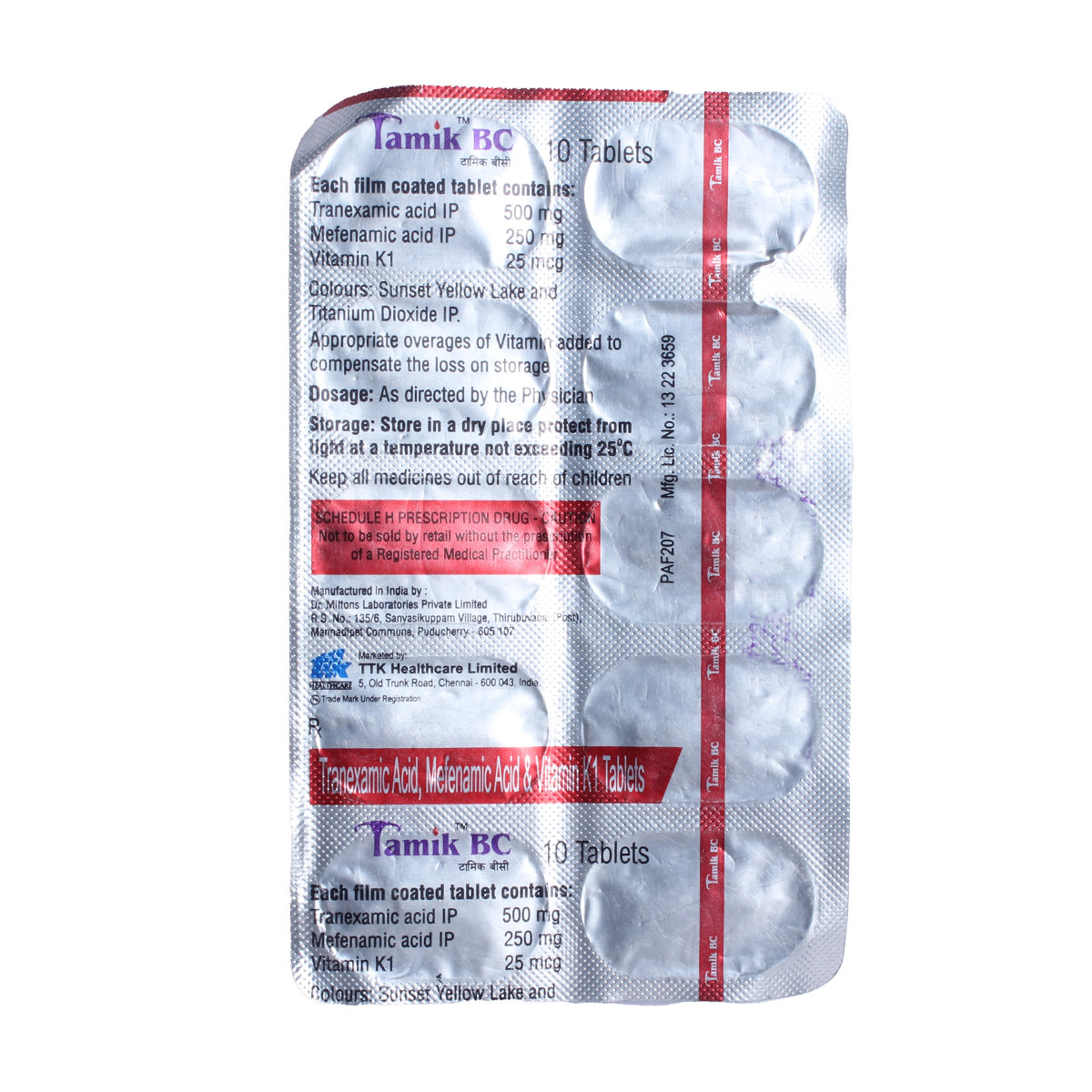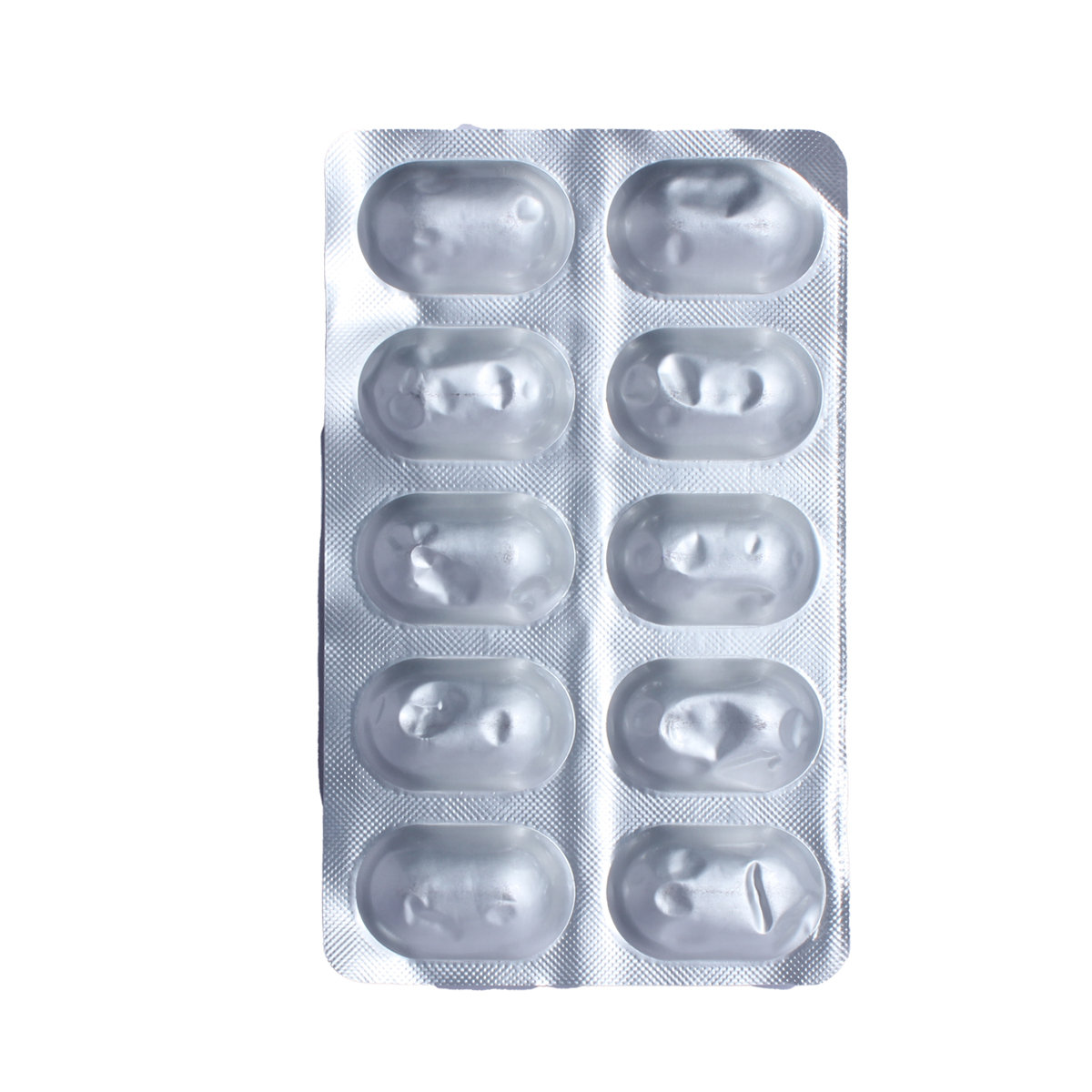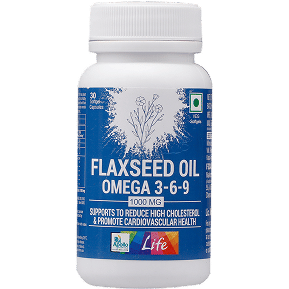Tamik BC Tablet


MRP ₹328.5
(Inclusive of all Taxes)
₹49.3 Cashback (15%)
know your delivery time
Provide Delivery Location
Manufacturer/Marketer :
Consume Type :
Expires on or after :
Return Policy :

Secure Payment

Trusted by 8 Crore Indians

Genuine Products
Therapeutic Class
Country of origin
Manufacturer/Marketer address
Disclaimer
Alcohol
Safe if prescribed
Consumption of alcohol is not recommended during treatment with this Tamik BC Tablet due to the increased risk of side effects such as dizziness, drowsiness, confusion, difficulty in concentrating, very low blood pressure, severe gastrointestinal bleeding, etc.
Pregnancy
Consult your doctor
Tamik BC Tablet is not recommended for use in pregnant women unless absolutely necessary. All the risks and benefits should be discussed with the doctor before taking this medicine. Your doctor may prescribe a safer alternative based on the clinical condition.
Breast Feeding
Consult your doctor
Tamik BC Tablet is not recommended for use in breastfeeding women unless absolutely necessary. All the risks and benefits should be discussed with the doctor before taking this medicine. Your doctor may prescribe a safer alternative based on the clinical condition.
Driving
Safe if prescribed
Tamik BC Tablet should not be used in driving if it impairs your mental ability.
Liver
Consult your doctor
Tamik BC Tablet to be taken with caution, especially if you have a history of liver diseases/conditions. The dose may have to be adjusted by your doctor.
Kidney
Consult your doctor
Tamik BC Tablet to be taken with caution, especially if you have a history of Kidney diseases/conditions. The dose may have to be adjusted by your doctor.
Children
Safe if prescribed
Tamik BC Tablet is not recommended for use in children less than 14 years of age.
About Tamik BC Tablet
Tamik BC Tablet belongs to the class of drugs known as 'anti-fibrinolytic'. Tamik BC Tablet is used to prevent bleeding. It is also known as a haemorrhage, or simply blood loss is blood escaping from the circulatory system from damaged blood vessels. Bleeding can occur internally, or externally either through a natural opening such as the mouth, nose, ear, urethra, vagina, or anus or through a wound in the skin.
Tamik BC Tablet is composed of three medicines namely: mefenamic acid, tranexamic acid, and vitamin K. Tamik BC Tablet which reduce excessive bleeding and pain. Mefenamic acid is a non-steroidal anti-inflammatory drug (NSAID) that works by blocking the release of certain chemical messengers that cause pain and inflammation (redness and swelling). Tranexamic acid is an anti-fibrinolytic. It works by helping blood clot normally to reduce bleeding during periods, or after surgery. Vitamin K is also a blood-clotting vitamin that controls excessive bleeding.
Like all medicines, Tamik BC Tablet may cause side effects, although not everybody gets them. Tamik BC Tablet cause common side effects like nausea, vomiting, heartburn, stomach pain, loss of appetite, diarrhoea, indigestion, headache, tiredness, anaemia (low number of red blood cells), sinus inflammation, sinus pain, nasal congestion (stuffy nose), musculoskeletal (bone, muscle, or joint) pain. If these side effects persist please consult your doctor immediately.
Do not take Tamik BC Tablet if you are allergic to Tamik BC Tablet . It is not recommended for use in children, people with liver disease, heart disease, or gastric ulcers/bleeding problems, asthma, clotting disorders, ophthalmic disorders, subarachnoid haemorrhage, and skin allergy. Avoid consumption of alcohol as it may damage your liver and cause even more side effects from taking this drug. Tamik BC Tablet is used with caution in coronary artery bypass surgery. Tamik BC Tablet is used with caution in skin allergies. Inform your doctor if you are a pregnant/breastfeeding woman.
Uses of Tamik BC Tablet
Medicinal Benefits Mweb
Key Benefits
Tamik BC Tablet is composed of three medicines namely: mefenamic acid, tranexamic acid, and vitamin K belong to the class of drugs known as 'anti-fibrinolytic'. Tamik BC Tablet is used to prevent bleeding. Tamik BC Tablet which reduces excessive bleeding and pain. Mefenamic acid is a non-steroidal anti-inflammatory drug (NSAID) that works by blocking the release of certain chemical messengers that cause pain and inflammation (redness and swelling). Tranexamic acid is an anti-fibrinolytic. It works by helping blood clot normally to reduce bleeding during periods, or after surgery. Vitamin K is also a blood-clotting vitamin that controls excessive bleeding.
Directions for Use
Side Effects of Tamik BC Tablet
- Nausea
- Vomiting
- Heartburn
- Stomach pain
- Loss of appetite
- Diarrhoea
- Indigestion
- Headache
- Tiredness
- Anaemia (low number of red blood cells)
- Sinus inflammation
- Sinus pain
- Nasal congestion (stuffy nose)
- Musculoskeletal (bone, muscle, or joint) pain
Drug Warnings
Do not take Tamik BC Tablet if you are allergic to Tamik BC Tablet . It is not recommended for use in children, people with liver disease, heart disease, or gastric ulcers/bleeding problems, asthma, clotting disorders, ophthalmic disorders, subarachnoid hemorrhage, and skin allergy. Avoid consumption of alcohol as it may damage your liver and cause even more side effects from taking this drug. Tamik BC Tablet is used with caution in coronary artery bypass surgery. Tamik BC Tablet is used with caution in skin allergies. Tamik BC Tablet is not recommended for use in women who are using hormonal contraceptives (pills, patches, vaginal rings, or injections) due to the increased risk of serious adverse effects. Inform your doctor if you are a pregnant/breastfeeding woman. Tamik BC Tablet is not recommended for use in children less than 14 years of age.
Drug-Drug Interactions
Drug-Drug Interactions
Login/Sign Up
Taking drospirenone with Tamik Bc Tab 10's *** may increase the risk of blood clot formation.
How to manage the interaction:
Taking Tamik Bc Tab 10's *** with Drospirenone is not recommended, as it can lead to an interaction but can be taken if prescribed by the doctor. However, If you suffer from chest discomfort, shortness of breath, blood in the urine, blood in the cough, sudden loss of vision, and pain, redness, or swelling in your arm or leg, consult your doctor immediately.
Taking Levonorgestrel with Tamik Bc Tab 10's *** may increase the risk of blood clot formation which can lead to serious conditions such as heart problems and kidney failure.
How to manage the interaction:
Taking Tamik Bc Tab 10's *** with Levonorgestrel may leads to an interaction but can be taken if prescribed by the doctor. However, if you experience chest pain; shortness of breath; coughing up blood; blood in the urine; sudden loss of vision; and pain, redness, or swelling in your arm or leg, consult the doctor immediately. Do not stop using any medications without talking to a doctor.
Taking Ethinylestradiol with Tamik Bc Tab 10's *** may increase the risk of blood clot formation.
How to manage the interaction:
Taking Ethinylestradiol with Tamik Bc Tab 10's *** is not recommended, as it can lead to an interaction, but can be taken if a doctor has prescribed it. However, if you suffer from chest discomfort, shortness of breath, blood in the urine, blood in the cough, sudden loss of vision, and pain, redness, or swelling in your arm or leg, consult doctor immediately. Do not stop using any medications without talking to a doctor.
Taking Medroxyprogesterone acetate with Tamik Bc Tab 10's *** may increase the risk of blood clots.
How to manage the interaction:
Taking Medroxyprogesterone with Tamik Bc Tab 10's *** is not recommended but can be taken if prescribed by a doctor. Consult your doctor immediately if you experience symptoms such as chest pain, shortness of breath, coughing up blood, blood in the urine, sudden loss of vision, and pain, redness, or swelling in your arm or leg. Do not stop using any medications without talking to your doctor.
Co-administration of Tamik Bc Tab 10's *** may cause blood clotting when taken with Etonogestrel.
How to manage the interaction:
Taking Tamik Bc Tab 10's *** with Etonogestrel is not recommended, as it can lead to an interaction but can be taken if prescribed by the doctor. However, If you suffer from chest discomfort, shortness of breath, blood in the urine, blood in the cough, sudden loss of vision, and pain, redness, or swelling in your arm or leg, consult your doctor immediately.
Coadministration of Tamik Bc Tab 10's *** with Ketorolac can increase the risk or severity of gastric bleeding and ulcers.
How to manage the interaction:
Taking Tamik Bc Tab 10's *** with Ketorolac together can result in an interaction, it can be taken if your doctor has advised it. However, if you notice any unusual bleeding or bruising, other signs of bleeding, dizziness, lightheadedness, red or black tarry stools, coughing up or vomiting blood, severe headache, and weakness, you should contact a doctor immediately. Do not stop using any medications without talking to a doctor.
Co-administration of Tamik Bc Tab 10's *** with Meloxicam together can increase the risk or severity of bleeding.
How to manage the interaction:
Taking Tamik Bc Tab 10's *** with Meloxicam together is generally avoided as it can result in an interaction, it can be taken if a doctor has advised it. However, if you notice any unusual bleeding or bruising, other signs of bleeding, dizziness, lightheadedness, red or black tarry stools, coughing up or vomiting blood, severe headache, and weakness, you should contact a doctor immediately. Do not stop using any medications without talking a doctor.
Using Tamik Bc Tab 10's *** together with norethindrone may increase the risk of blood clots.
How to manage the interaction:
Taking norethisterone with Tamik Bc Tab 10's *** can lead to an interaction, however, it can be taken only if a doctor has advised it. If you experience symptoms such as chest pain, shortness of breath, coughing up blood, blood in the urine, sudden loss of vision, and pain, redness, or swelling in your arm or leg, contact a doctor immediately .Do not discontinue any medications without consulting a doctor.
Co-administration of Carfilzomib with Tamik Bc Tab 10's *** can increase the risk of blood clots.
How to manage the interaction:
Taking carfilzomib with Tamik Bc Tab 10's *** is not recommended due to its increased effects, however, it can be taken only if a doctor has advised it. If you experience symptoms such as chest pain, shortness of breath, difficulty breathing, coughing up blood, sudden loss of vision, pain, and numbness or weakness on one side of the body contact a doctor immediately. Do not discontinue any medications without consulting a doctor.
Co-administration of Estramustine with Tamik Bc Tab 10's *** can increase the risk of blood clots.
How to manage the interaction:
Taking Estramustine with Tamik Bc Tab 10's *** possibly lead to an interaction, however, it can be taken only if a doctor has advised it. If you experience symptoms such as chest pain, shortness of breath, difficulty breathing, coughing up blood, sudden loss of vision, pain, and numbness or weakness on one side of the body contact a doctor immediately. Do not discontinue any medications without consulting a doctor.
Drug-Food Interactions
Drug-Food Interactions
Login/Sign Up
Drug-Diseases Interactions
Drug-Diseases Interactions
Login/Sign Up
Drug-Drug Interactions Checker List
- ASPIRIN
- RAMIPRIL
- PROPRANOLOL
- WARFARIN
- GLIMEPIRIDE
- TAMOXIFEN
- ETHINYLESTRADIOL
- METHOTREXATE
- TRETINOIN
Habit Forming
Special Advise
- Do not stop Tamik BC Tablet suddenly, please consult your doctor immediately.
Diet & Lifestyle Advise
- Avoid large glasses of juice, soft drinks, energy drinks, and sweetened tea.
- Avoid heavy gravies and sauces.
- Avoid butter, shortening, or lard.
- Avoid full-fat dairy products.
- AVoid candy.
- Avoid foods containing trans fats, including fried foods and baked goods (pastries, pizza, pie, cookies, and crackers).
- By choosing a healthy diet and getting the proper exercise, people with bleeding disorders can help improve their physical health and well-being.
- The USDA recommends eating a diet rich in whole grains, fruits, and vegetables, and low in solid fats added sugars, and salt (sodium) in your diet.

Have a query?
Buy best Vascular System products by
Emcure Pharmaceuticals Ltd
Intas Pharmaceuticals Ltd
Lupin Ltd
Ozone Pharmaceuticals Ltd
Sun Pharmaceutical Industries Ltd
Cipla Ltd
Leeford Healthcare Ltd
Mercury Laboratories Ltd
Torrent Pharmaceuticals Ltd
FDC Ltd
Macleods Pharmaceuticals Ltd
Akumentis Healthcare Ltd
Dr Reddy's Laboratories Ltd
Indoco Remedies Ltd
Mankind Pharma Pvt Ltd
Oaknet Healthcare Pvt Ltd
Reliance Formulation Pvt Ltd
Samarth Life Sciences Pvt Ltd
Walter Bushnell
Wanbury Ltd
Abbott India Ltd
Eris Life Sciences Ltd
Galcare Pharmaceuticals Pvt Ltd
Juggat Pharma Ltd
Knoll Pharmaceuticals Ltd
Kontest Pharmaceuticals
Saf Fermion Ltd
Serdia Pharmaceuticals India Pvt Ltd
Systopic Laboratories Pvt Ltd
Themis Chemicals Ltd
Akcent Healthcare India Pvt Ltd
Alembic Pharmaceuticals Ltd
Amelia Healthcare Pvt Ltd
Canixa Life Sciences Pvt Ltd
East West Pharma India Pvt Ltd
German Remedies Ltd
Glenmark Pharmaceuticals Ltd
Ipca Laboratories Ltd
La Pristine Bioceuticals Pvt Ltd
Morepen Laboratories Ltd
Nexgen Rx Life Science Pvt Ltd
Pfizer Ltd
Rapross Pharmaceuticals Pvt Ltd
Sumac Pharma Pvt Ltd
Theia Health Care Pvt Ltd
Themis Medicare Ltd
Themis Pharmaceutical Ltd
4Care Lifesciences Pvt Ltd
Aar Ess Remedies Pvt Ltd
Aarux Pharmaceuticals Pvt Ltd
Alna Biotech Pvt Ltd
Aphia Healthcare
Aristo Pharmaceuticals Pvt Ltd
Baxter India Pvt Ltd
Bennet Pharmaceuticals Ltd
Bharat Serums and Vaccines Ltd
Biosys Pharmaceuticals Ltd
Bros Enterprises Ltd
Celebrity Biopharma Ltd
Chemo Healthcare Pvt Ltd
Cibeles Pharmaceuticals Pvt Ltd
Comed Chemicals Ltd
Conatus Healthcare Pvt Ltd
Cresha Lifesciences
Cute Care Life Sciences Pvt Ltd
Elbrit Life Sciences Pvt Ltd
Euro Biogenics
Icon Life Sciences
J B Chemicals & Pharmaceuticals Ltd
Kee Pharma Ltd
Kemiq Lifesciences Pvt Ltd
Kivi Labs Ltd
Lincoln Pharmaceuticals Ltd
Medchronic Health Care
Medgen Drugs And Laboratories Pvt Ltd
Megma Healthcare Pvt Ltd
Novartis India Ltd
Olcare Laboratories Pvt Ltd
Ornate Labs Pvt Ltd
Q Check Pharmaceuticals
Saan Labs
Stadmed Pvt Ltd
Std Pharmaceuticals Pvt Ltd
Zydus Cadila
3G Life Sciences
Accent Pharmaceuticals & Diagnostics
Adroit Biomed Ltd
Aishwarya Healthcare
Ajanta Pharma Ltd
Akesiss Pharma Pvt Ltd
Albert David Ltd
Algen Healthcare Ltd
Amazone Pharmaceuticals Pvt Ltd
Amstel Pharma Pvt Ltd
Anhox Healthcare Pvt Ltd
Apios Lifesciences Pvt Ltd
Args India Pharma Pvt Ltd
Ark Life Science Pvt Ltd
Arvincare
Aztomax Biotech
Customers Also Bought



